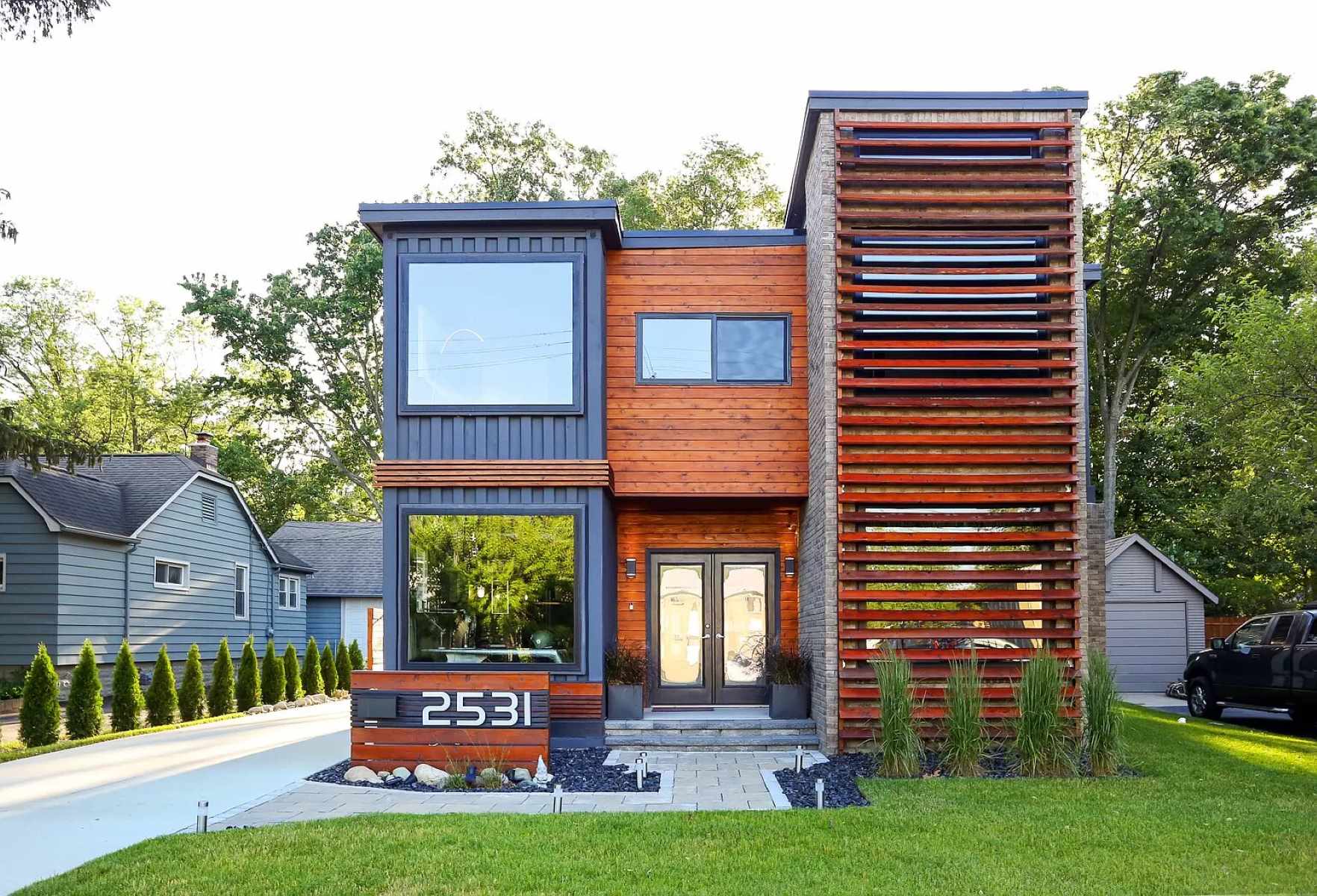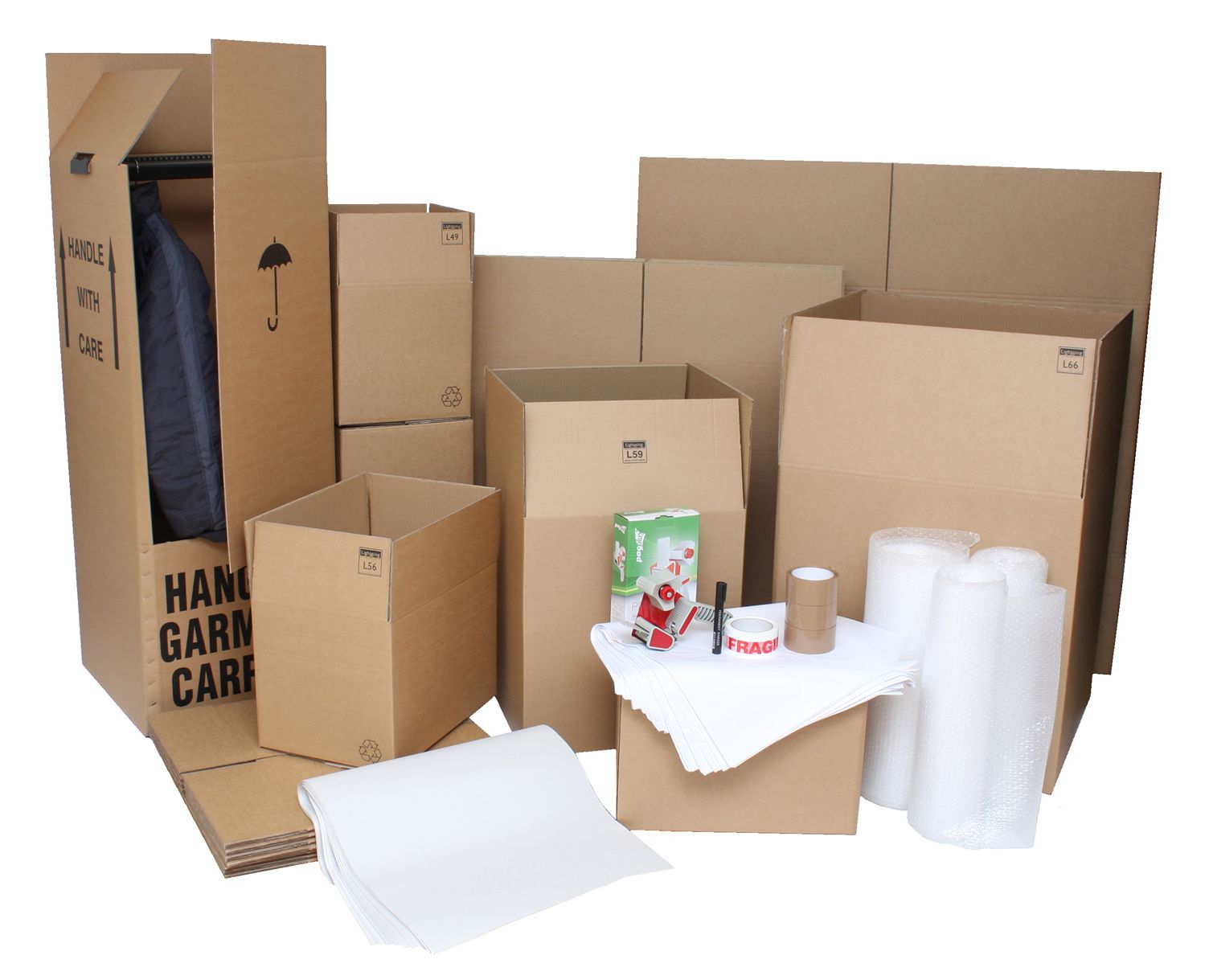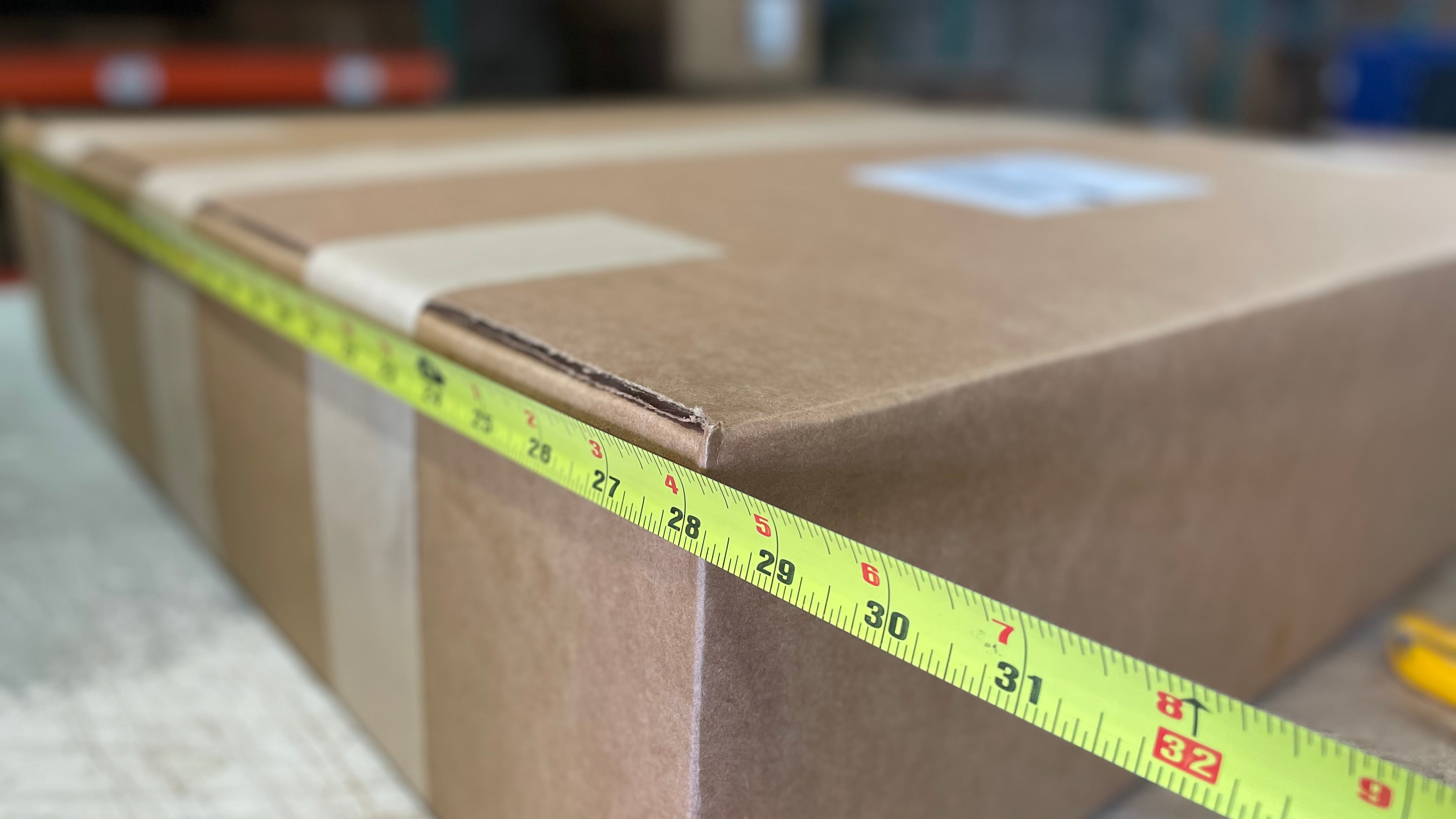Home>diy>Architecture & Design>How To Design A Shipping Container House


Architecture & Design
How To Design A Shipping Container House
Modified: March 6, 2024
Learn how to design an innovative shipping container house with our expert tips and techniques. Get inspired by our unique architecture design ideas and create your dream home today.
(Many of the links in this article redirect to a specific reviewed product. Your purchase of these products through affiliate links helps to generate commission for Storables.com, at no extra cost. Learn more)
Introduction
Welcome to the world of innovative architectural design! In recent years, shipping container houses have gained immense popularity due to their unique aesthetic appeal, eco-friendly nature, and affordability. These houses are not only sustainable but also provide immense flexibility in terms of design and functionality. If you are intrigued by the idea of living in a shipping container house or simply want to explore the realm of cutting-edge architecture, this article is for you.
In this comprehensive guide, we will take you through the process of designing a shipping container house from start to finish. Whether you are a seasoned architect or an aspiring homeowner with a knack for creative design, this article will equip you with the knowledge and inspiration to embark on this exciting and sustainable building journey.
Before we dive into the nitty-gritty details, let’s first explore some of the key benefits of shipping container houses that have captured the imagination of architects and homeowners worldwide.
Key Takeaways:
- Designing a shipping container house offers affordability, sustainability, and design flexibility. Consider local regulations, choose the right containers, and plan the layout to create a unique and functional living space.
- Prioritize structural modifications, insulation, and energy-efficient systems to ensure safety, comfort, and environmental friendliness. Collaborate with professionals, obtain permits, and embrace sustainability for a successful construction process.
Read more: How To Connect A Porch Roof To House
Benefits of Shipping Container Houses
Shipping container houses offer a plethora of benefits that make them an appealing choice for individuals looking for a unique and sustainable living solution. Here are some of the key advantages:
- Affordability: One of the major advantages of shipping container houses is their cost-effectiveness. Compared to traditional construction methods, building a house using shipping containers can be significantly cheaper. The main reason for this is that containers are readily available and can be repurposed for residential use at a fraction of the cost of building from scratch.
- Quick Construction: Shipping container houses are known for their quick construction time. Once the containers are delivered to the construction site, the assembly process can be completed in a matter of weeks. This is especially appealing for individuals who are looking to move into their new homes quickly or for those who want to minimize construction time and associated costs.
- Eco-Friendly: With the increasing focus on sustainable living, shipping container houses are a perfect fit. By repurposing shipping containers, we are not only reducing waste but also minimizing the need for new construction materials. Additionally, these houses can incorporate green features such as solar panels, rainwater harvesting systems, and energy-efficient appliances, further reducing their environmental footprint.
- Design Flexibility: Shipping containers provide immense design flexibility. They can be stacked, combined, and modified to create unique and aesthetically appealing living spaces. Whether you’re looking for a small, minimalist home or a spacious family retreat, shipping container houses can easily accommodate your design preferences.
- Durability: Shipping containers are designed to withstand harsh weather conditions and the rigors of international shipping. Constructed from sturdy materials, these containers can withstand wind, water, and other external elements. This durability translates into a long-lasting and low-maintenance housing option.
These are just a few of the many benefits that shipping container houses offer. As we delve deeper into the design process, you’ll discover even more advantages and intricacies involved in creating a unique and sustainable living space using shipping containers.
Considerations Before Designing a Shipping Container House
Before you embark on the design process of a shipping container house, it’s important to consider a few key factors to ensure a successful and seamless project. Here are some essential considerations:
- Local Regulations and Permits: Research and understand the local building codes, zoning regulations, and permit requirements in your area. Different regions have specific guidelines for building with shipping containers, and it’s crucial to adhere to these regulations to avoid any legal complications during the construction process.
- Site Selection: Choose an appropriate location for your shipping container house. Consider factors such as accessibility, orientation to maximize natural light, and proximity to amenities and utilities. Assess the soil conditions and any potential site-specific challenges that may impact the construction process.
- Size and Layout: Determine the size and layout of your shipping container house based on your living requirements and available space. Consider the number of bedrooms, bathrooms, living areas, and storage needs. Plan the layout to optimize the use of available space while ensuring good circulation and functionality.
- Climate and Insulation: Take into account the climate of your location and plan for proper insulation to ensure comfort and energy efficiency. Shipping containers are made of steel, which can conduct heat and cold. Insulating the walls, roof, and floor will help maintain a comfortable interior temperature regardless of the external weather conditions.
- Utilities and Services: Determine the connection points for utilities such as water, electricity, and sewage. Ensure there is proper access to these services on your chosen site. Consider the placement of HVAC systems, water heaters, and other mechanical components to ensure efficient operation.
- Budget and Timeframe: Set a realistic budget for your project, taking into account not just construction costs but also permits, site preparation, landscaping, and interior finishes. Define a timeline that aligns with your budget and personal needs, considering any potential delays or unexpected challenges that may arise during the construction process.
- Design and Aesthetic: Consider the overall design concept and aesthetic you want to achieve. Explore various design inspirations and determine the architectural style and interior finishes that suit your taste. Balance functionality with aesthetics to create a harmonious and inviting living space.
Taking these considerations into account will help you lay a solid foundation for the design process of your shipping container house. Keeping an open mind and seeking professional advice from architects, engineers, and contractors experienced in working with shipping containers can further enhance the success of your project.
Steps to Designing a Shipping Container House
Designing a shipping container house involves a series of steps that will transform your vision into a reality. These steps will guide you through the process, from selecting the right containers to adding the finishing touches. Here is a breakdown of the key steps:
- Choosing the Right Containers: Determine the number and size of containers you will need based on your desired layout and space requirements. Consider factors such as structural integrity, condition, and previous use when selecting containers. Inspect containers for any damage or corrosion that may affect their suitability for construction.
- Planning the Layout: Sketch out a rough layout of your shipping container house, taking into account the placement of rooms, windows, doors, and circulation spaces. Consider natural light, privacy, and functional flow when organizing the interior space. This step will help you visualize the overall design and make adjustments before moving forward.
- Structural Modifications: Work with a professional architect or engineer to determine the necessary modifications to reinforce the containers and achieve the desired structural integrity. This may involve cutting openings for doors and windows, removing sections of walls, or adding additional supports. Ensure that all modifications comply with local building codes and regulations.
- HVAC and Electrical Systems: Plan and install the heating, ventilation, air conditioning (HVAC), and electrical systems. This includes the placement of HVAC units, ductwork, outlets, switches, and light fixtures. Engage the services of licensed professionals to ensure safety and compliance with electrical codes.
- Insulation and Ventilation: Apply insulation to the walls, roof, and floor of the containers to provide adequate thermal and sound insulation. Choose insulation materials that are moisture-resistant and suitable for the local climate. Install proper ventilation systems to maintain a healthy and comfortable indoor environment.
- Interior Design and Finishes: Select interior finishes, such as flooring, wall finishes, cabinetry, and fixtures, that align with your design aesthetic and desired functionality. Consider the use of sustainable materials and efficient space utilization to create a welcoming and visually appealing interior space.
- Plumbing and Bathroom Fixtures: Plan and install plumbing systems, including supply lines, drains, and fixtures for kitchen and bathroom areas. Take into account local plumbing codes and regulations to ensure proper installation and functionality.
- Sustainability and Energy Efficiency: Incorporate sustainable design features such as solar panels, rainwater harvesting systems, and energy-efficient appliances to reduce your environmental impact and lower utility costs. Seek guidance from experts in sustainable design to maximize the efficiency of your shipping container house.
- Permits and Regulations: Obtain the necessary permits and approvals from local authorities before commencing construction. This includes building permits, electrical permits, plumbing permits, and any other required documentation. Ensure compliance with all relevant regulations to avoid any legal issues during or after the construction process.
By following these steps and working with experienced professionals, you can successfully design and build your very own shipping container house. Embrace the unique opportunities that this innovative form of architecture offers and create a living space that is both functional and aesthetically pleasing.
Choosing the Right Containers
When embarking on the design process of a shipping container house, the first step is to choose the right containers for your project. Here are some key considerations to keep in mind:
- Size and Quantity: Determine the number of containers you will need based on your desired layout and space requirements. Shipping containers typically come in two standard sizes: 20 feet and 40 feet in length. Assess your needs and work with an architect or designer to determine the appropriate number and size of containers for your project.
- Structural Integrity: Inspect the containers for any damage or corrosion that may affect their structural integrity. Look for signs of rust, holes, or dents. Choose containers that are in good condition and structurally sound. Note that newer containers are often in better condition compared to older ones.
- Previous Use: Consider the previous use of the containers. Some containers may have been used to transport hazardous materials or chemicals, which could potentially leave behind residue or odors. It’s advisable to choose containers that were previously used for non-toxic cargo to ensure a safe living environment.
- Supplier and Certification: Purchase containers from reputable suppliers who provide certification for quality and authenticity. Look for containers that meet ISO (International Organization for Standardization) standards, as they are designed to withstand the rigors of international shipping and are built with high-quality materials.
- Delivery and Placement: Consider the logistics of delivery and placement of the containers on your construction site. Ensure that there is sufficient space for trucks or cranes to maneuver and place the containers in the desired location. Take into account any clearance requirements, access points, and site conditions that may impact delivery and placement.
Choosing the right containers is crucial to the success of your shipping container house project. By selecting containers that are structurally sound, in good condition, and meet your requirements, you are laying a strong foundation for the rest of the design and construction process.
Read more: How To Ship A Kegerator
Planning the Layout
Once you have chosen the right containers for your shipping container house, the next step is to plan the layout of your living space. This involves considering how many rooms you need, where they should be located, and how they will flow together. Here are some key factors to keep in mind when planning the layout:
- Functionality: Consider how you will use the different spaces in your shipping container house. Determine the number of bedrooms, bathrooms, living areas, kitchen, and any additional rooms such as a home office or storage space. Think about how these spaces will interact and facilitate a comfortable and functional living experience.
- Natural Light and Views: Take advantage of the natural light available on your site and plan the placement of windows accordingly. Incorporate large windows and skylights to maximize natural light and connect the interior space with the surrounding environment. Consider views and orient the layout to take advantage of appealing vistas or privacy screens as needed.
- Circulation and Traffic Flow: Design the layout to allow for smooth circulation and efficient traffic flow between different areas of the house. Ensure there are clear pathways and avoid any awkward or inconvenient passages that could hinder movement. Consider how doors will open, where furniture will be placed, and how people will move through the space.
- Privacy: Plan for adequate privacy in areas such as bedrooms and bathrooms. Consider the placement of walls, doors, and windows in a way that provides privacy without compromising on natural light and views. Take into account the orientation of neighboring properties and ensure that your layout maintains privacy from outside observers.
- Accessibility and Universal Design: If you anticipate a need for accessibility or want to future-proof your home, consider incorporating universal design principles. Ensure that doorways, hallways, and spaces are wide enough to accommodate wheelchair users or individuals with mobility challenges. Install fixtures and fittings that are easily accessible and functional for people of all abilities.
Mapping out the layout of your shipping container house is an essential step in creating a functional and enjoyable living space. By carefully considering the functionality, natural light, traffic flow, privacy, and accessibility, you can design a layout that meets your needs and enhances your overall living experience.
Structural Modifications
Once you have chosen the containers and planned the layout for your shipping container house, the next step is to make any necessary structural modifications to the containers. This step is crucial to ensure the containers are strong, safe, and suitable for residential use. Here are some key considerations when making structural modifications:
- Opening and Cutouts: Determine where you want to create openings for doors, windows, and entryways in the containers. Consult with a structural engineer or architect to assess the impact of these modifications on the overall integrity of the containers. Proper supports, headers, and reinforcements may need to be added to maintain the structural stability of the containers.
- Welding and Joining: Welding is often required when joining multiple containers together to create larger living spaces or multi-story structures. It is crucial to engage experienced welders or professionals who are knowledgeable about working with steel containers. Ensure that all welding is done to industry standards and regulations to maintain the structural strength of the containers.
- Roof Reinforcements: Assess the load-bearing capacity of the container roofs to determine if additional reinforcements are required. The roof area is often used for outdoor spaces, green roofs, or solar panel installations. Reinforcing the roof with support beams or trusses can ensure it can safely accommodate the intended use and any additional load.
- Vertical and Horizontal Supports: Evaluate the need for vertical and horizontal supports to provide stability and prevent sagging or buckling of the containers. Depending on the design and layout, additional supports or beams may be necessary to distribute the weight evenly and maintain the integrity of the containers.
- Sealing and Waterproofing: Proper sealing and waterproofing are essential to protect the interior of the containers from moisture and weather elements. Ensure that all openings, joints, and seams are properly sealed to prevent water infiltration. Consider adding insulation to the walls, roof, and floor to reduce condensation and improve thermal performance.
It is important to consult with professionals specializing in shipping container modifications to ensure that all structural changes comply with local building codes and regulations. Their expertise will help ensure the safety, integrity, and longevity of your shipping container house.
When designing a shipping container house, make sure to carefully plan the layout and consider insulation, ventilation, and structural reinforcement to ensure a comfortable and safe living space.
HVAC and Electrical Systems
As you proceed with designing your shipping container house, it’s crucial to plan and install appropriate HVAC (Heating, Ventilation, and Air Conditioning) and electrical systems to ensure a comfortable and functional living environment. Here are some important considerations for these systems:
- HVAC System Selection: Assess the heating and cooling needs of your shipping container house based on your climate zone and insulation levels. Determine the most suitable HVAC system, whether it’s a central air conditioner, a mini-split system, or radiant heating. Consult with HVAC professionals to size and select the system that best meets your requirements.
- Ductwork and Ventilation: Plan the routing of ductwork and ventilation systems to ensure proper air circulation throughout the house. Consider the limited wall space in shipping containers and explore alternative ductwork options, such as utilizing ceiling or underfloor spaces. Install vents strategically to maintain airflow and ensure proper ventilation in all areas.
- Electrical System Design: Determine the electrical needs of your shipping container house. Consider the number and location of outlets, switches, and lighting fixtures. Plan the electrical panel location and wiring routes to ensure easy access for maintenance and safety. Engage a licensed electrician to design and install the electrical system in compliance with local electrical codes.
- Energy Efficiency: Incorporate energy-efficient appliances, lighting fixtures, and HVAC systems to minimize energy consumption and reduce utility costs. Consider using LED lighting, smart thermostats, and energy-efficient appliances that align with your sustainability goals. Explore renewable energy options, such as solar panels, to further reduce your carbon footprint.
- Backup Power: If you live in an area prone to power outages, consider installing a backup power system, such as a generator or battery backup. This can provide emergency power to essential systems and appliances during outages, ensuring uninterrupted functionality and comfort in your shipping container house.
Collaborating with HVAC and electrical professionals throughout the design and installation process is crucial to ensure that all systems are properly sized, installed, and comply with local regulations. Their expertise will help you create a comfortable, energy-efficient living space that meets your specific needs and enhances your overall experience in your shipping container house.
Insulation and Ventilation
Proper insulation and ventilation are essential for creating a comfortable and energy-efficient living space in your shipping container house. Since metal containers have a high thermal conductivity, insulation helps regulate temperature and mitigate condensation issues. Here are some considerations for insulation and ventilation:
- Insulation Materials: Choose insulation materials that are suitable for your climate, provide effective thermal resistance (R-value), and comply with local building codes. Common options include spray foam insulation, rigid foam boards, mineral wool, or eco-friendly alternatives like recycled denim or cellulose insulation.
- Wall Insulation: Apply insulation to the interior walls of the shipping containers to reduce heat transfer and prevent temperature fluctuations. Consider using insulation with vapor barriers to control moisture levels and minimize condensation issues. Ensure that the insulation does not obstruct electrical wiring or pose a fire hazard.
- Roof and Floor Insulation: Insulate the roof and floor of your shipping container house to further enhance thermal performance. Apply insulation materials that are suitable for these areas and ensure proper sealing to prevent air leakage. Depending on the design, insulating the underside of the container’s floor or adding an additional layer can help improve comfort and energy efficiency.
- Ventilation Systems: Plan for adequate ventilation to promote healthier indoor air quality and prevent the buildup of moisture or stale air. Install exhaust fans in kitchens and bathrooms to remove excess humidity. Consider incorporating windows or vents to allow for natural airflow throughout the house. Mechanical ventilation systems like heat recovery ventilators (HRVs) or energy recovery ventilators (ERVs) can help exchange stale indoor air with fresh outdoor air while minimizing energy loss.
- Moisture Control: Proper insulation and ventilation play a key role in controlling moisture levels inside your shipping container house. Insulate and seal the walls, roof, and floor properly to prevent condensation. Monitor and manage moisture levels by using dehumidifiers, ensuring proper drainage systems, and performing regular inspections for any signs of water intrusion or mold growth.
Consulting with insulation and ventilation experts can ensure that you select the right materials, techniques, and systems for your shipping container house. They can provide guidance in maintaining a comfortable indoor environment while mitigating potential moisture-related issues.
Read more: How To Add A Porch To Your House
Interior Design and Finishes
The interior design and finishes of your shipping container house play a crucial role in creating a functional and aesthetically pleasing living space. Here are some key considerations for designing the interior of your shipping container house:
- Utilize the Space: Maximize the use of available space by incorporating clever storage solutions and multi-functional furniture. Explore built-in cabinets, wall-mounted shelves, and modular furniture to optimize space utilization. Consider customizing furniture or fixtures to fit the unique dimensions of the shipping containers.
- Color Palette and Lighting: Choose a color palette that suits your design aesthetic and enhances the overall ambiance of the space. Lighter colors can make the interior appear more spacious, while darker hues can add warmth and create a cozy atmosphere. Incorporate a mix of natural and artificial lighting to create a well-lit and inviting environment.
- Interior Finishes: Select appropriate finishes for the walls, ceilings, and floors. Depending on your style preferences, consider options such as paint, wallpaper, reclaimed wood, or eco-friendly materials like bamboo or cork for the flooring. Ensure that the chosen finishes are durable, easy to clean, and suitable for the specific area they will be used in.
- Window Treatments: Install window treatments that provide privacy, light control, and enhance the overall design. Consider options like curtains, blinds, or shades that are functional yet stylish. These treatments can also help with insulation by reducing unwanted heat gain or loss through windows.
- Furnishings and Décor: Incorporate furniture and décor that reflect your personal style and lifestyle. Opt for comfortable seating, functional storage solutions, and pieces that serve multiple purposes. Consider adding personal touches through artwork, plants, and accessories to make the space feel more inviting and reflective of your personality.
- Sustainable Materials: Embrace sustainability by using eco-friendly and recycled materials in your interior design. Look for furniture made from reclaimed or sustainably sourced wood. Incorporate energy-efficient appliances and fixtures to reduce your environmental impact. Explore options for repurposing or upcycling materials to add unique and environmentally conscious elements to your shipping container house.
Collaborating with an interior designer can provide valuable insights and expertise in creating a cohesive and visually appealing interior for your shipping container house. They can help you strike the right balance between functionality, aesthetics, and sustainability, resulting in a comfortable and stunning living space.
Plumbing and Bathroom Fixtures
Designing the plumbing system and selecting bathroom fixtures for your shipping container house is essential for creating a functional and comfortable living space. Here are some key considerations for plumbing and bathroom fixtures:
- Layout and Design: Plan the layout of your bathroom space, taking into consideration the available square footage and desired fixtures. Determine the location of the toilet, sink, shower, and any additional features like a bathtub or bidet. Ensure the layout allows for ease of movement and sufficient space for each fixture.
- Water Supply and Drainage: Assess the water supply and drainage systems available on your site and plan the connection points accordingly. Consult with a plumber to ensure proper installation of pipes and connections. Consider the use of low-flow faucets, showers, and toilets to conserve water and reduce utility costs.
- Bathroom Fixtures: Choose fixtures that fit the style and functionality of your shipping container house. Look for compact and space-saving options that are still comfortable to use. Consider the quality and durability of fixtures, selecting ones made from materials that can withstand the challenges of a shipping container environment.
- Ventilation: Proper ventilation is crucial to prevent the buildup of excess humidity and minimize the risk of mold or mildew growth. Install exhaust fans or windows in the bathroom to facilitate air circulation and remove moisture. Ensure that the ventilation system complies with local building codes and provides sufficient airflow for the size of the space.
- Hot Water System: Determine the appropriate hot water system for your shipping container house. This can be a conventional water heater or a tankless, on-demand system that provides hot water as needed. Consider the size of the hot water tank or the capacity of the tankless system to ensure it can meet the demands of your household.
- Accessories and Storage: Incorporate accessories such as towel bars, hooks, and shelves for storage and organization. Utilize wall-mounted or freestanding storage solutions to optimize space in a compact bathroom. Consider adding mirrors and proper lighting fixtures to enhance functionality and aesthetics.
Collaborating with a plumber or bathroom designer can ensure that your plumbing system is properly designed and installed, and that the bathroom fixtures meet your needs and design preferences. They can offer guidance on plumbing codes, water-saving options, and solutions tailored to the unique challenges of a shipping container house.
Sustainability and Energy Efficiency
Designing a sustainable and energy-efficient shipping container house not only benefits the environment but also helps reduce utility costs and create a healthier living space. Here are some key considerations to make your home more sustainable and energy-efficient:
- Solar Power: Consider installing solar panels on the roof of your shipping container house to generate clean and renewable energy. Solar power can help offset your electricity consumption and reduce your carbon footprint. Consult with a solar energy professional to determine the optimal panel size and placement based on your energy needs and available sunlight.
- Insulation: Proper insulation plays a significant role in reducing energy consumption by minimizing heat transfer, improving temperature regulation, and reducing reliance on heating or cooling systems. Ensure that walls, roof, and floor are well-insulated with materials that have a high R-value and are suitable for your climate zone.
- Energy-Efficient Appliances: Choose energy-efficient appliances and fixtures for your shipping container house. Look for appliances with the ENERGY STAR label, which indicates that they meet strict energy efficiency standards. Consider energy-efficient lighting options like LED bulbs, which consume less electricity and have a longer lifespan compared to traditional incandescent bulbs.
- Water Conservation: Incorporate water-saving features to minimize water consumption within your shipping container house. Install low-flow faucets, showerheads, and toilets that use less water without compromising performance. Consider using greywater systems to recycle water from sinks, showers, and laundry for non-potable uses, such as irrigation.
- Natural Ventilation: Maximize natural ventilation by strategically placing windows and vents to encourage airflow throughout the house. This can help reduce reliance on mechanical ventilation systems and improve indoor air quality. Consider incorporating operable windows, skylights, or louvers to facilitate cross-ventilation and remove stale air.
- Rainwater Harvesting: Explore the option of collecting and utilizing rainwater for non-potable purposes, such as watering plants or flushing toilets. Install rainwater harvesting systems that redirect rainwater from the roof into storage tanks or barrels. Ensure the system includes proper filtration and purification methods for safe and efficient use.
By implementing sustainable design strategies and energy-efficient technologies, you can create a shipping container house that aligns with your eco-conscious values and reduces environmental impact. Collaborate with sustainability experts and professionals to explore innovative solutions for making your home greener and more energy-efficient.
Permits and Regulations
Before beginning the construction of your shipping container house, it is important to understand the permits and regulations required by your local authorities. Here are some key considerations regarding permits and regulations:
- Research Local Building Codes: Familiarize yourself with the local building codes and regulations that apply to your area. These codes outline the safety standards, structural requirements, and other specifications that must be met during the construction process. Research the specific guidelines for building with shipping containers to ensure compliance.
- Permit Requirements: Determine the permits required for your shipping container house project. This may include building permits, electrical permits, plumbing permits, and any other relevant documentation. Contact the local building department or permitting office to understand the specific requirements and application processes.
- Engage Professionals: Consider consulting with architects, engineers, and contractors experienced in working with shipping containers. Their expertise can help you navigate the permit application process and ensure that your design and construction plans meet all necessary regulations and requirements.
- Site Inspections: Prepare for site inspections during various stages of the construction process. Inspectors will visit your site to assess compliance with building codes and regulations. These inspections will focus on structural modifications, electrical and plumbing installations, insulation, and overall safety considerations. Be prepared to address any concerns raised during inspections.
- Neighborhood and HOA Guidelines: In addition to local building codes, ensure compliance with any neighborhood or homeowners’ association (HOA) guidelines that may apply to your property. These guidelines often outline aesthetic requirements, setback distances, and other restrictions that must be adhered to during the construction and design processes.
- Environmental Considerations: If your project involves site excavation or other activities that may impact the environment, you may need to obtain additional permits or comply with environmental regulations. This ensures adherence to regulations concerning factors such as erosion control, tree preservation, and stormwater management.
- Insurance Coverage: Before starting the construction of your shipping container house, ensure that you have the necessary insurance coverage to protect your investment during the construction process. Consult with insurance providers to understand your coverage options and any specific requirements that need to be met.
It is crucial to be well-informed about the permits and regulations governing the construction of your shipping container house. By staying informed, engaging professionals, and following the necessary steps to obtain permits, you can ensure a smooth and compliant construction process.
Read more: How To Ship A Bed Frame
Conclusion
Designing a shipping container house is an exciting and innovative endeavor that offers numerous benefits, including affordability, sustainability, and design flexibility. By following the step-by-step guide outlined in this article, you can embark on this unique architectural journey with confidence and success.
Before diving into the design process, it is important to consider factors such as local regulations, site selection, and budget. These considerations will lay the foundation for a smooth and compliant construction process. Choosing the right containers and planning the layout are key steps that will shape the overall design and functionality of your shipping container house.
Structural modifications, HVAC and electrical systems, insulation and ventilation, and plumbing fixtures must be carefully considered to ensure your home is safe, comfortable, and efficient. By incorporating sustainable materials, energy-efficient technologies, and proper insulation and ventilation techniques, you can create a home that is environmentally friendly and cost-effective.
Seamlessly integrating interior design and finishes, including furniture selection, color palettes, and lighting, will transform your shipping container house into a stylish and personalized living space. Additionally, complying with permits and regulations, engaging professionals, and addressing environmental considerations are crucial to ensure a smooth construction process and compliance with local regulations.
In conclusion, designing a shipping container house requires careful planning, attention to detail, and collaboration with professionals, but the end result is a unique, sustainable, and functional living space. With creativity, thoughtful decision-making, and an understanding of the key considerations outlined in this guide, you can bring your vision to life and enjoy the benefits of living in a shipping container house.
Frequently Asked Questions about How To Design A Shipping Container House
Was this page helpful?
At Storables.com, we guarantee accurate and reliable information. Our content, validated by Expert Board Contributors, is crafted following stringent Editorial Policies. We're committed to providing you with well-researched, expert-backed insights for all your informational needs.













0 thoughts on “How To Design A Shipping Container House”